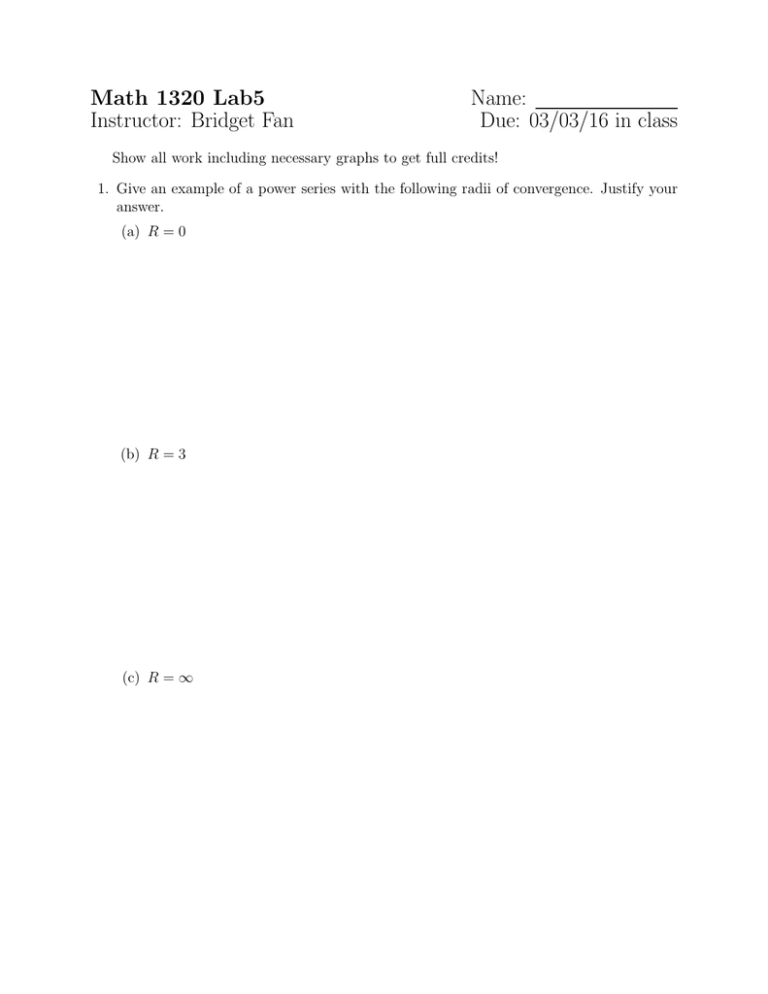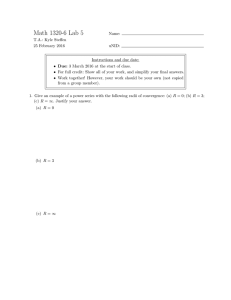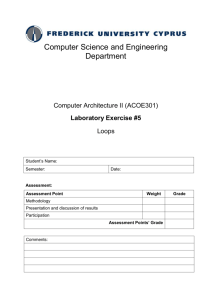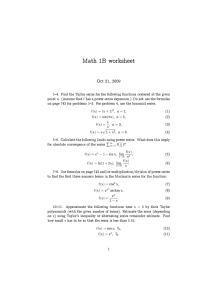Math 1320 Lab5 Name: Instructor: Bridget Fan Due: 03/03/16 in class
advertisement

Math 1320 Lab5 Instructor: Bridget Fan Name: Due: 03/03/16 in class Show all work including necessary graphs to get full credits! 1. Give an example of a power series with the following radii of convergence. Justify your answer. (a) R = 0 (b) R = 3 (c) R = ∞ Math 1320 Lab5 Page 2 of 4 2. Consider the function f (t) = (arctan t)/t. Rx (a) Compute a power series expansion of I(x) = f (t)dt. Write your answer in the 0 P∞ 2k−1 form k=1 ak x for an appropriate choice of ak . (b) Compute the radius of convergence of the resulting power series expansion. (c) Let In (x) = n X ak x2k−1 be the n-th partial sum of the series in part (a) (i.e. k=1 it consists of the first n terms of the power series). Define En to be the error of approximating I(1) by In (1): En = |I(1) − In (1)|. What is the minimum number of terms N required so that EN < 0.01? What if we require EN < 0.001? EN < 0.000001 = 10−6 ? (Hint: Use the Alternating Series Estimation Theorem. Also: All three of your answers should be positive integers.) Math 1320 Lab5 Page 3 of 4 3. Consider the following graph (in blue) of a function f (x). Answer the following questions, and justify your answer with a short sentence or two. 3 2 y 1 0 −1 −2 −3 −5 −4 −3 −2 −1 (a) Is 0 x 1 2 3 4 5 3 1 1 5 − x + x2 + x3 − x4 + · · · the Maclaurin series of f (x)? 4 2 2 8 5 5 1 5 5 (b) Is − + (x + 1) + (x + 1)2 + (x + 1)3 − (x + 1)4 + · · · the Taylor series of 7 9 4 12 7 f (x) at the point x = −1? 8 8 3 15 3 + (x − 3) + (x − 3)2 + (x − 3)3 − (x − 3)4 + · · · the Taylor series of 5 9 18 31 11 f (x) at the point x = 3? (c) Is Math 1320 Lab5 Page 4 of 4 4. The following limits represent some derivative of f (x). Use Taylor series to determine which derivative it is. 1 (a) lim 2 [f (x + h) + f (x − h) − 2f (x)] h→0 h 1 [f (x + h) − f (x − h)] h→0 2h (b) lim



